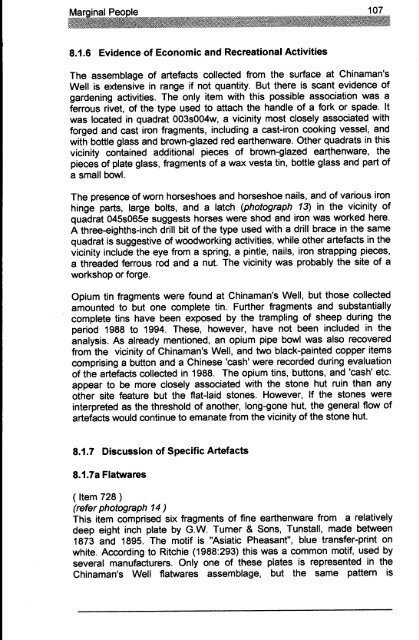Adec Preview Generated PDF File - The Sydney eScholarship ...
Adec Preview Generated PDF File - The Sydney eScholarship ...
Adec Preview Generated PDF File - The Sydney eScholarship ...
You also want an ePaper? Increase the reach of your titles
YUMPU automatically turns print PDFs into web optimized ePapers that Google loves.
8.1.6 Evidence of Economic and Recreational Activities<br />
<strong>The</strong> assemblage of artefacts collected from the surface at Chinaman's<br />
Well is extensive in range if not quantity. But there is scant evidence of<br />
gardening activities. <strong>The</strong> only item with this possible association was a<br />
ferrous rivet, of the type used to attach the handle of a fork or spade. It<br />
was located in quadrat 003s004w, a vicinity most closely associated with<br />
forged and cast iron fragments, inclUding a cast-iron cooking vessel, and<br />
with bottle glass and brown-glazed red earthenware. Other quadrats in this<br />
vicinity contained additional pieces of brown-glazed earthenware, the<br />
pieces of plate glass, fragments of a wax vesta tin, bottle glass and part of<br />
a small bowl.<br />
<strong>The</strong> presence of worn horseshoes and horseshoe nails, and of various iron<br />
hinge parts, large bolts, and a latch (photograph 13) in the vicinity of<br />
quadrat 045s065e suggests horses were shod and iron was worked here.<br />
A three-eighths-inch drill bit of the type used with a drill brace in the same<br />
quadrat is suggestive of woodworking activities, while other artefacts in the<br />
vicinity include the eye from a spring, a pintle, nails, iron strapping pieces,<br />
a threaded ferrous rod and a nut. <strong>The</strong> vicinity was probably the site of a<br />
workshop or forge.<br />
Opium tin fragments were found at Chinaman's Well, but those collected<br />
amounted to but one complete tin. Further fragments and substantially<br />
complete tins have been exposed by the trampling of sheep during the<br />
period 1988 to 1994. <strong>The</strong>se, however, have not been included in the<br />
analysis. As already mentioned, an opium pipe bowl was also recovered<br />
from the vicinity of Chinaman's Well, and two black-painted copper items<br />
comprising a button and a Chinese 'cash' were recorded during evaluation<br />
of the artefacts collected in 1988. <strong>The</strong> opium tins, buttons, and 'cash' etc.<br />
appear to be more closely associated with the stone hut ruin than any<br />
other site feature but the flat-laid stones. However, If the stones were<br />
interpreted as the threshold of another, long-gone hut, the general flow of<br />
artefacts would continue to emanate from the vicinity of the stone hut.<br />
8.1.7 Discussion of Specific Artefacts<br />
8.1.7a Flatwares<br />
( Item 728)<br />
(refer photograph 14)<br />
This item comprised six fragments of fine earthenware from a relatively<br />
deep eight inch plate by G.W. Turner & Sons, Tunstall, made between<br />
1873 and 1895. <strong>The</strong> motif is "Asiatic Pheasant", blue transfer-print on<br />
white. According to Ritchie (1988:293) this was a common motif, used by<br />
several manufacturers. Only one of these plates is represented in the<br />
Chinaman's Well f1atwares assemblage, but the same pattern is




